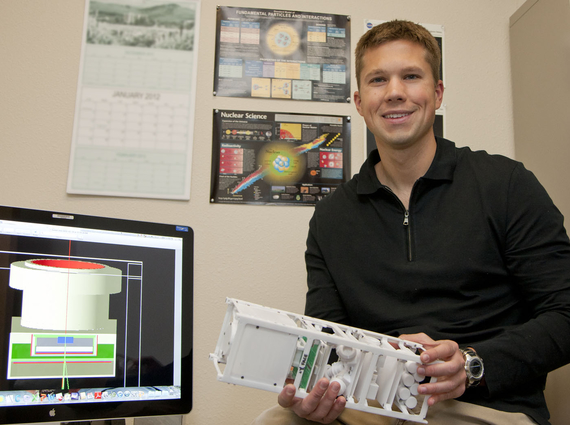In search of... the dark sky
Simms, a postdoc in the Lab's Physics Division, has been working for a year on a NASA project called the Cosmic X-Ray Background Nanosatellite (CXBN). Set for an August launch, the breadbox-sized satellite -- built in conjunction with UC Berkeley, Sonoma State University and Morehead State University Space Science Center -- will gather X-ray data from the cosmos and beam it back to earth.
Most X-ray telescopes aboard satellites use focusing optics to determine how much energy is emitted from a particular source or region, such as the Crab Nebula. The Crab Nebula is a supernova remnant that emits X-ray energies above 30 kilo-electron volts (keV) and is considered the strongest persistent source of X-rays in the sky.
CXBN, on the other hand, is not interested in examining particular regions, but instead will provide an improved measurement of the universe's X-Ray background -- which is coming from all directions in space -- and could help resolve a mystery in modern cosmology -- the origin of the cosmic X-ray background.
While the microwave background radiation is well understood -- studied since the mid-1960s -- the X-ray background is less well understood and few measurements exist that allow astronomers to interpret its origin. In fact, the two existing X-ray measurements are somewhat imprecise.
"Right now, we can't see the source of radiation," Simms said. "The theory is that the sources of the background are farther than we can see with optical or infrared telescopes. With CXBN we'll be able to more precisely measure the radiation and place constraints on what the sources could be."
Simms played a critical role in the project by modeling and simulating the Cadmium Zinc Telluride (CZT) detector on board the nanosatellite. He also wrote the control software that moves the spacecraft.
Simms said it's likely that the X-rays emitted from the cosmic background could be coming from active galactic nuclei, or AGNs, which are compact areas at the center of galaxies that gives off an enormous amount of energy. The radiation from AGNs is believed to be a result of accretion of mass by the supermassive black hole at the center of a galaxy.
Because AGNs are one of the most consistent sources of radioactive energy in the universe, it could help pinpoint the evolution of the cosmos.
Other researchers include Garrett Jernigan of UC Berkeley; Steve Anderson of Sonoma State; John Doty of Noqsi Aerospace; and Ben Malphrus, Kevin Brown, Tyler Rose, Luke Lim, Roger McNeil and Jeff Kruth, all of Morehead University.
Contact
Anne M Stark[email protected]
925-422-9799
Tags
Physical and Life SciencesFeatured Articles









